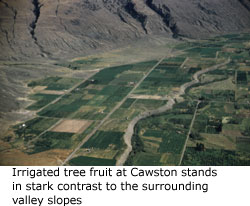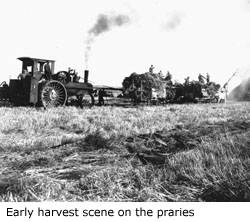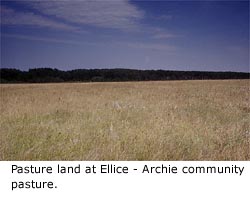
 The North American Prairies is contained within the Nelson River basin which has a drainage
area of
approximately 1,062,000 square kilometres. The Canadian Prairies comprise approximately
three-quarters of this area. The prairie area is bounded on the south by the International
Boundary. Its easterly boundary commences in the southeast corner of Manitoba and bisects that
province in a northwesterly direction. It intersects the Manitoba-Saskatchewan provincial
boundary near The Pas, where the Saskatchewan River Valley crosses that boundary. The
northern boundary continues westerly from this point to approximately 240 kilometres north and
east of Edmonton. The western boundary follows the foothills of the Continental Divide south to
the international boundary.
The North American Prairies is contained within the Nelson River basin which has a drainage
area of
approximately 1,062,000 square kilometres. The Canadian Prairies comprise approximately
three-quarters of this area. The prairie area is bounded on the south by the International
Boundary. Its easterly boundary commences in the southeast corner of Manitoba and bisects that
province in a northwesterly direction. It intersects the Manitoba-Saskatchewan provincial
boundary near The Pas, where the Saskatchewan River Valley crosses that boundary. The
northern boundary continues westerly from this point to approximately 240 kilometres north and
east of Edmonton. The western boundary follows the foothills of the Continental Divide south to
the international boundary.

The area has a general slope in an east to northeasterly direction. In the extreme southwest corner of Alberta, the elevation is 1,160 metres and on the eastern fringe in Manitoba the elevation is 240 metres. The topographic characteristics and relief of the Prairies were created by the numerous glaciations 15,000 years ago. After the final (Wisconsinian) glacial period, meltwater from the retreating ice sheet formed several large lakes in lowland portions of the Prairies. The thick layers of lacustrine soils now found in much of the region are a legacy of centuries of sedimentation processes in these lakes. As the glacial lakes drained south into the Mississippi River basin, numerous meltwater channels were created. Some of these former channels now provide ideal sites for reservoirs. It is possible to distinguish three general levels on the Prairies. The first, in the eastern portion, is the flat featureless lake bottom of the former glacial Lake Agassiz. Proceeding west is an escarpment comprised of the Riding, Duck and Porcupine Mountains.This feature is located near the western boundary of the province of Manitoba. West of this lies the second level, consisting of gently rolling prairie with little relief.
A second escarpment which cuts northwest across central Saskatchewan is
known as the Missouri Coteau. The Coteau creates the third level that gradually rises westward
to the foothills. This is the most irregular in its relief, due to erosion of the original ice-planed flat
surfaces. The general relief of the two western levels consists of abandoned channels of ancient
streams that contain several of the smaller remaining lakes or intermittent streams. Many of
these are closed drainage basins.

The western half of the Prairies is drained by the Saskatchewan River system, the eastern half by
the Souris Assiniboine-Red River systems. These rivers mostly flow in deep valleys 15
to 60 metres below the general land surface, although the prairie area, as previously mentioned,
comprises
about three-quarters of the Nelson River drainage basin. It contributes
only about eight per cent to the total average annual runoff of the basin, due to its rolling
topography. It has been estimated that
the runoff from two-thirds of the prairie area terminates in closed basins.